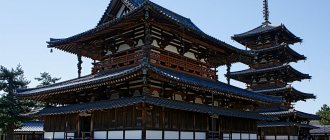Miraculous properties
A pagoda is a multi-tiered temple tower (obelisk, pavilion) with numerous bright decorations and cornices. Initially, it served as a memorial, preserving numerous relics - the remains of Buddhas and the ashes of monks. The construction of the very first pagodas dates back to the beginning of our era.
Having appeared in China, they spread widely throughout Southeast Asia and the Far East. According to ancient Chinese legends, pagodas were intended to heal people from illnesses, to comprehend the truth through meditation, and also to gain the ability to become invisible to enemies. However, too many bad human actions led to the fact that these structures began to “hide” their miraculous power.
History[edit]
Japan's oldest three-story pagoda at Hokki-ji, Ikaruga, Nara Prefecture.
It was built in 706. Mortar
there was originally a simple mound containing the Buddha's ashes, which over time became more complex, and its pommel grew proportionately larger.
[2] Upon reaching China, the stupa met a Chinese watchtower and became a pagoda, a tower with an odd number of floors. [note 1] Its use then spread to Korea and from there to Japan. After arriving in Japan along with Buddhism in the 6th century, the pagoda became one of the central sites of early Japanese garana
. [note 2] In Japan it changed in shape, size and function, eventually losing its original role as a reliquary. [5] It has also become extremely common, while rare on the Asian continent. [6]
With the emergence of new sects in subsequent centuries, the pagoda lost importance and was therefore relegated to the edge of the guarantee
. Temples of the Jodo sects rarely have a pagoda. [2] During the Kamakura period, the Zen sect arrived in Japan and their temples are not usually included in the pagoda.
Pagodas were originally reliquaries and did not contain sacred images, but in Japan many, such as the five-story Huryu-ji Pagoda, contain statues of various deities. [5] To open up the ground floor room and thus create some usable space, the pagoda's central shaft, which originally extended to the ground, was shortened to the upper floors, where it rested on support beams. [5] This room contains statues of the temple's main objects of worship. Inside Shingon pagodas there may be images of deities called Shingon Hasso (真言八祖); there may be decorations and paintings on the ceiling and on the central shaft. [5]
Evolution of design and structure[edit]
The edge of the pagoda cornice forms a straight line, with each subsequent edge shorter than the other. The greater the difference in length (a parameter called teigen in Japanese
(逓減, gradual decrease ) ) between stories, the more durable and reliable the pagoda seems.
Both the Teigen
and the finial are larger in older pagodas, giving them a sense of solidity. [5] Conversely, modern pagodas tend to be steeper and have shorter finials, creating slimmer silhouettes.
From a structural point of view, old pagodas had a stone base (心礎, shinsō) above which a main column (心柱, shinbashira) rose. The first floor support pillars will be built around it, then the beams that support the cornices, and so on. The remaining floors will be built on top of the completed one, and a finial will finally be inserted on top of the main column. [5] In later eras, all support structures would be erected at once, with more cosmetic parts attached to them later. [5]
In early pagodas, the central column went deep into the ground. As architectural techniques evolved, it was first placed on a foundation stone at ground level, then shortened and placed on beams on the second floor to open up the room. [2] [5]
Their role in the temple gradually declined, while they were functionally replaced by the main halls ( condos
).
They were originally the centerpiece of guarantees
, but they were later moved to its edges and finally abandoned, particularly by the Zen sects that were the last to appear in Japan.
Loss of pagoda importance in guarantee[edit]
Reconstruction of the original layout of Asuka-dera with a pagoda in the center.
Because of the relics they contained, wooden pagodas used to be the centerpiece of the guarantee
, seven buildings that were considered indispensable to the temple.
[7] They gradually lost their
significance and were replaced by
the kondo
(golden hall) due to the magical powers believed to reside in the images housed in the building.
This loss of status was so complete that the Zen schools that arrived late to Japan from China usually do not have a pagoda in their guarantee
.
The layout of the four early temples clearly illustrates this trend: they are arranged in the chronological order of Asuka-dera, Shitenno-ji, Hūryū-ji, and Yakushi-ji. [7] In the first, the pagoda was located in the very center of the guarantor,
surrounded by three small
condos
(see Reconstruction of the original plan of the temple).
In the second case,
in the center of the temple there is a single
condo,
and in front of it is a pagoda.
In Huryu-ji they stand next to each other. Yakushi-ji has one large kondo
in the center with two pagodas on either side. The same evolution can be observed in Buddhist temples in China.
Mysterious treasures
The meaning of the word "pagoda" literally translated from Portuguese (pagoda) and Sanskrit ("bhagavat") is "tower of treasures." Most of the monastery buildings have retained their original purpose, but access for travelers to active monasteries is limited. The park buildings play a rather symbolic role, attracting many tourists with their unique interior decoration and the opportunity to view the surrounding area from the height of any tier. But you cannot see ritual ceremonies and truly sacred objects in them.
The brilliant splendor of sacred buildings, perfectly combined with noble tranquility, resembles, and often is, palace complexes. The Imperial Pagoda is a building stylized with particular pomp and grandeur, covered with yellow tiles, the color of which symbolized the supreme power.
Architectural delights
Chinese builders erected structures using original technology based on the wooden frame structure “dougong”, translated as “bucket and beam”. Not a single iron nail was used in the construction of such houses. Having arranged the pillars in a certain order and fastened them with crossbars, the Chinese installed a frame, which was subsequently covered with a roof made of heavy tiles. But the most interesting thing: to relieve pressure on the pillars, the Chinese built truncated pyramids from wooden blocks, the wide bases of which rested on the upper ceiling, and the tops on the pillar. As a result, the entire load falls on these blocks, which differed in size and shape and were called “dow” - “bucket”, respectively, “gun” - “beam”.
Thus, the pagoda is an amazing structure in which the walls do not bear any load. They perform the functions of partitions and allow you to install windows and doors in any quantity.
Notes[edit]
- Odd numbers are very popular in Chinese numerology and Buddhism. They are supposed to personify, that is, the masculine and positive principle, and are therefore considered lucky.
- A temple complex, ideally consisting of seven buildings.
- Besides being decorative in themselves, they are also used to hide structural elements that would otherwise detract from the feel of the pagoda.
- See also the articles by Hisashi
, Mokoshi and Moya. - However, due to lack of
space, the wall separating
the mokoshi
from the core of the pagoda is only present in the large
tahoto
called
daito
(see next section).
Intricate Features
The earliest Chinese pagodas were built in the shape of a square, and later buildings became hexagonal, octagonal and dodecagonal, some round. You can find wooden and stone buildings, but bricks, iron and copper were often used. The number of levels in ancient Chinese pagodas is usually odd; the most common buildings are those with 5-13 levels. The imagination of the architects erected elegant buildings that miraculously fit into the surrounding natural space and form a unique architectural ensemble. Traditionally, such buildings were built in mountainous areas, away from the noisy central regions of China.
Gallery of pagodas in Japan[edit]
- gorintō
- hōkyōintō
- A hōt
- Stone taso
- Two Kasatoba
in
Hannya
-ji, Nara - Ichijo-ji's SANJU-no
(three floors of the pagoda). It was built in 1171.
- No Muro-ji's Goju-ne-k
(five floors of the pagoda). It was built in 800.
- Pagoda at a Shinto shrine, Itsukushima Shrine
- Sotoba
. The division into five parts is clearly visible.
- sorinto
Pagoda in Shanxi province, palace buildings
Of particular interest is the uniqueness of the 9-level pagoda (its height is 70 meters) in Shanxi province, built about a thousand years ago. This is the oldest wooden building in the world that has survived to this day. Moreover, the uniqueness of the anti-seismic design saved it from numerous destructive earthquakes.
Chinese pagodas in the style of palace buildings focus on the greatness of the emperor. Graceful, curved roofs, decorated with figures of birds and animals, serve to drain rainwater away from the base of the building. This allows you to protect wooden walls from moisture and makes these structures more durable.
Stone pagodas[edit]
Rare 16-story stone pagoda at Chosho-ji in Kamakura
Stone Pagodas ( sekito
) are usually made from materials such as apatite or granite, they are much smaller than wood and are finely carved.
[5] They often bear Sanskrit inscriptions, Buddhist figurines, and Japanese nengo
.
Like wood, they are mainly classified based on the number of stories as tasoto
or
hoto
, but nevertheless, there are some styles that are almost never found in wood, namely
gorinto
,
muhoto
,
hokyinto
and
kasatoba
. [8]
Tasoto or Tajuto[edit]
With very rare exceptions, Tasoto
(also called
tajuto
, 多層塔) has an odd number of stories, usually between three and thirteen.
[9] They are usually less than three meters in height, but sometimes they can be much taller. The tallest still extant is the 13-story pagoda at Hannya-ji in Nara, which is 14.12 m high. They are often dedicated to the Buddha and offer no useful space, but some have a small space inside where the sacred image is kept. [8] In the oldest surviving example, although the edges of each floor are parallel to the ground, each subsequent floor is smaller than the next, resulting in a highly sloping curve. More modern flavors
have a less pronounced twist.
- Media related to Tasoto at Wikimedia Commons
Ht[edit]
Hoto
in Ankokuron-ji
Hoto
(宝塔, lit. jewel stupa) is a pagoda consisting of four parts: a low foundation stone, a cylindrical body with a rounded top, a four-sided roof, and a finial.
[10] Unlike the similar tahoto
(see section below), it does not have an enclosed pitched roof (
mokoshi
) around the round core.
[5] Like Tahoto,
it takes its name from the Buddhist deity Taho Nyorai.
Hoto
was born during the early Heian period, when the Tendai and Shingonsects first arrived in Japan. In fact, since it is not found on the Asian continent, it is believed to have been invented in Japan. [5]
There used to be full-size hotos
, but almost only miniature ones have survived, usually made of stone and/or metal. [10]
- Media related to Ht at Wikimedia Commons?
Gorinto[edit]
Main article: Gorintō
gorintō
Gorintō
(五輪塔, lit. five ring tower) is a pagoda found almost exclusively in Japan, and is believed to have been first adopted by the Shingon and Tendai sects during the mid-Heian period.
[11] It is used as a grave marker or as a cenotaph and is therefore often found in Buddhist temples and cemeteries. It is also called gorinsotoba
(五輪卒塔婆) ("five-ring stupa") or
goringedatsu
(五輪解脱), where the term
sotoba
is a transliteration of the Sanskrit word stupa. [1]
In all its variations, gorinto
consists of five blocks (although this number can sometimes be difficult to determine), each of which has one of five shapes that symbolize the five elements believed to be the basic building blocks of reality: earth (cube), water (sphere), fire (pyramid), air (crescent) and ether, energy or emptiness (lotus). [11] The last two rings (etheric and ethereal) are visually and conceptually combined into a single subgroup.
- Media related to Gorinto at Wikimedia Commons
Hōkyōintō [edit]
Main article: Hōkyōintō
hōkyōintō
Hōkyōintō
(宝篋印塔) large stone pagoda is so called because it originally contained the Hōkyōin (宝篋印) dharani (陀羅尼) sutra. [1] It was originally used as a cenotaph for the Wuyue king Qian Liu in China. [1]
Hōkyōintō
traditions in Japan are believed to have begun during the Asuka period (550-710 AD).
[12] They were previously made of wood and only began to be made of stone during the Kamakura period. [12] It was during this period that they began to be used as tombstones and cenotaphs. [12] hōkyōintō
began to be made in its current form during the Kamakura period.
[1] Like gorinto
, it is divided into five main parts, representing the five elements of Japanese cosmology.
[5] The sutra, which he sometimes hides, contains all the pious deeds of the Tathagata. The Buddha and believers believe that by praying before the hokyointo
, their sins will be cancelled, they will be protected from disasters during life, and they will go to heaven after death. [12]
- Media related to Hkyōintō at Wikimedia Commons
Muhōt or rantō [edit]
muhōtō
Muhōtō
(無縫塔, lit. stitch tower) or
rantō
(卵塔, lit. egg tower) is a pagoda that usually marks the tomb of a Buddhist priest. It was originally used only by Zen schools, but was later adopted by others. [13] Its characteristic ovoid upper part is considered a phallic symbol.
- Media related to Muhoto at Wikimedia Commons?
Kasatōba[edit]
Kasatōba
(笠塔婆, umbrella stupa) (see photo in gallery below) is simply a square stone placed over a square base and covered with a pyramidal roof. A bowl-shaped stone and a lotus-shaped stone rise above the roof. The shaft may be carved with Sanskrit words or bas-relief images of Buddhist gods. There may be stone wheels inside the shaft that allow worshipers to turn the stupa while praying, as with a prayer wheel. [14]
- Media related to Kasatba at Wikimedia Commons
Serinto[edit]
Sōrintō
(相輪橖) is a type of small pagoda consisting of only a pole and
a sorin
.
Japanese pagoda – music of Buddha
Creating an atmosphere of spirituality, in the Japanese garden it is customary to build Buddhist temples on hills, natural or artificial. Traditionally, when arranging a garden, a gate is first installed, and then a Japanese pagoda, which is the central compositional object.
The height of the structure is not limited by anything except... stone lanterns, which should be 1.5-2 times lower than the pagoda. In the land of the rising sun, they can be very small (up to 1 meter), located in a miniature garden. This means that there are no stone lanterns in the visibility zone at all. According to classical canons, a pagoda is a structure consisting of individual stones and forming a square at the base. Its vertical section is a trapezoid with curved sides. The most interesting thing is that the stones in the Japanese pagoda are not fixed to each other, and the building is supported by their own weight. Therefore, when constructing it, careful calculation and accuracy are very important.
Against the backdrop of magnificent landscapes, multi-tiered pagodas reign in a calming and spiritual atmosphere, differing in shape, height and bright colors. They invariably attract attention and excite human imagination.
How to visit the temple
Be calm and respectful. Show your respect by tossing a coin in the offering box. Then recite (pretend to) a short prayer in front of the sacred object.
In some temples, visitors burn incense (Osenko) in large incense burners. Buy a pack, light them, let them burn for a few seconds, and then put out the flame by waving your hand rather than blowing it out. Finally, place the incense in the incense burner and hold some of the smoke near you, as the smoke is believed to have healing powers. For example, if you have an injured shoulder, apply some smoke to your shoulder.
You may be required to remove your shoes when entering temple buildings. Leave your shoes on the shelves at the entrance; if you are concerned about their safety, take them with you in a plastic bag provided in some temples. Wear nice, intact socks. Remove your headdress.
Photography is usually permitted on temple grounds, but is often prohibited inside buildings. Follow the explanatory signs.
Views: 1,692
Share link:
- Tweet
- Share posts on Tumblr
- Telegram
- More
- by email
- Seal
Liked this:
Like










